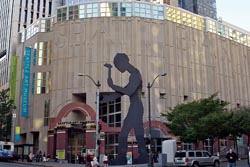Exhibiting Depth

- The downtown Seattle Art Museum, a crown jewel in the city's vibrant cultural life and home to works spanning human history across cultures, recently underwent an $86 million renovation that included Smetrix's SymNet DSP systems (below).SEATTLE, WA-Constantine Zachariou, engineer and project manager for Washington-based AV design firm Avidex, was contracted to handle the audio renovation of the downtown Seattle Art Museum. For the museum's downtown location, Zachariou chose Symetrix's SymNet DSP systems to be at the heart of each of the six new audio systems. His objective was to upgrade the museum's audio systems to handle the museum's many uses while still ensuring transparent, easy operation for the museum staff.
- In the Nordstrom lecture hall, a SymNet BreakIn12 analog input expander extends a SymNet 8x8 DSP at the core of the system for 20 analog inputs and eight analog outputs. In this application, the front-end takes inputs from line and mic inputs from the stage, ceiling mics, a booth computer, and a video playback system. The SymNet 8x8 DSP handles all of the necessary mixing, processing, and output functions.
- Zachariou's greatest challenge in the system design was overcoming a number of acoustical deficiencies. "Spaces were acoustically challenging," he noted. "I was glad to have all of the DSP processing capability of the SymNet units-any kind of filter, any kind of EQ, any kind of routing, anything. I just dropped it into the signal path. That made it as easy as it could have been, which," he laughed, "still wasn't too easy!"
The museum's Plestcheeff auditorium's system is similar to the lecture hall, except that the stage has many more inputs, the video system has many more components, and the house has many more loudspeakers. In addition, live events are mixed from a Mackie digital console, the outputs of which feed the DSP for distribution to output devices, loudspeakers, and monitors. To handle the greater number of inputs and significant increase in processing required by the larger system, Zachariou added a second SymNet 8x8 DSP to the system. The two units link together via SymNet's low-latency 64-channel SymLink Bus. A single SymNet Designer program runs both units.
Two public spaces replete with artwork and a large, divisible meeting room were added as part of the museum's renovation and expansion. Again, a SymNet 8x8 DSP with an accompanying BreakIn12 input expander sit at the center of all three systems and are fed by line and microphone inputs, as well as audio playback devices. With these and the other two systems, a vital component of Zachariou's successful design was only indirectly related to the audio itself. He had to make each system, with its numerous inputs and envisioned uses, intuitive and easy to use by museum staff.
Zachariou opted to use a network-based Pacific Interactive control system to connect the DSP "guts" of the system to the larger world. A crucial component of the human design involved collecting only the relevant information that a user would need to access and making all of the necessary background changes happen transparently. Thus, pushing a single button may shift signal paths, change EQ settings, and turn various inputs or outputs on or off, among other changes.
A daily selection of the top stories for AV integrators, resellers and consultants. Sign up below.
The AVNetwork staff are storytellers focused on the professional audiovisual and technology industry. Their mission is to keep readers up-to-date on the latest AV/IT industry and product news, emerging trends, and inspiring installations.
